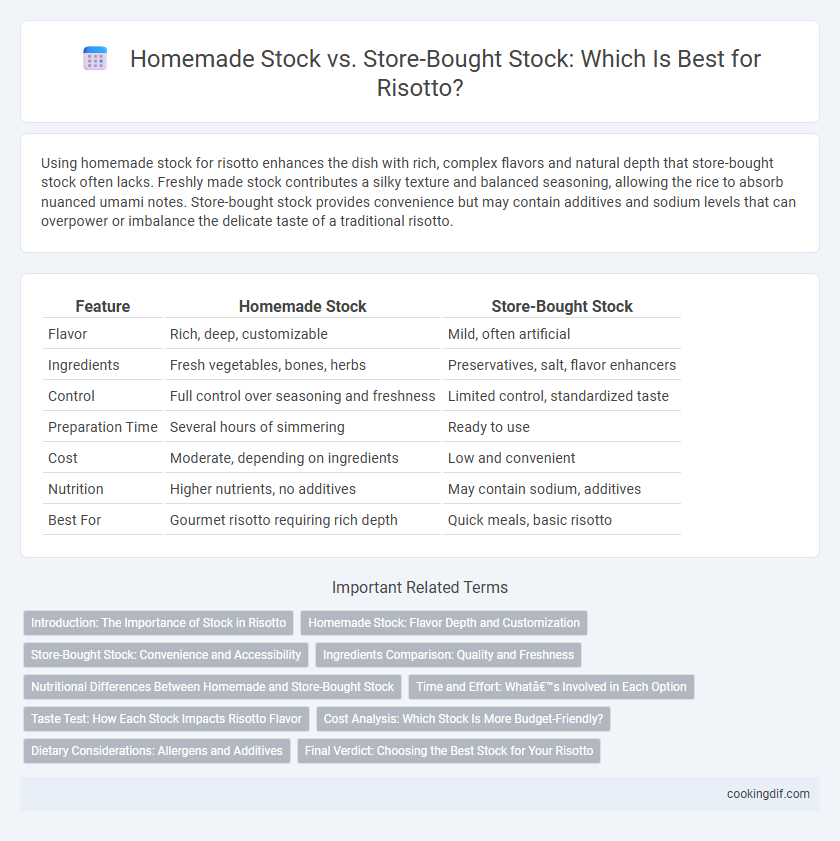Using homemade stock for risotto enhances the dish with rich, complex flavors and natural depth that store-bought stock often lacks. Freshly made stock contributes a silky texture and balanced seasoning, allowing the rice to absorb nuanced umami notes. Store-bought stock provides convenience but may contain additives and sodium levels that can overpower or imbalance the delicate taste of a traditional risotto.
Table of Comparison
| Feature | Homemade Stock | Store-Bought Stock |
|---|---|---|
| Flavor | Rich, deep, customizable | Mild, often artificial |
| Ingredients | Fresh vegetables, bones, herbs | Preservatives, salt, flavor enhancers |
| Control | Full control over seasoning and freshness | Limited control, standardized taste |
| Preparation Time | Several hours of simmering | Ready to use |
| Cost | Moderate, depending on ingredients | Low and convenient |
| Nutrition | Higher nutrients, no additives | May contain sodium, additives |
| Best For | Gourmet risotto requiring rich depth | Quick meals, basic risotto |
Introduction: The Importance of Stock in Risotto
Stock serves as the foundational liquid in risotto, significantly influencing the dish's flavor and texture. Homemade stock, crafted from simmered bones, vegetables, and herbs, offers a richer, more complex taste with natural gelatin that enhances creaminess. In contrast, store-bought stock may contain additives and lack depth, potentially resulting in a less vibrant risotto.
Homemade Stock: Flavor Depth and Customization
Homemade stock enhances risotto with rich, complex flavors derived from simmering fresh vegetables, herbs, and bones, providing a depth unmatched by store-bought alternatives. Its customization allows precise control over seasoning and intensity, adapting perfectly to the desired taste profile of the dish. Using homemade stock pools nutrients and natural gelatin, resulting in a creamier, more flavorful risotto consistency.
Store-Bought Stock: Convenience and Accessibility
Store-bought stock offers unmatched convenience and accessibility for risotto preparation, making it an ideal choice for busy cooks seeking consistent flavor without lengthy preparation times. Commercially available stocks come in a variety of types, such as chicken, vegetable, and beef, often enhanced with natural seasonings to provide a rich, balanced base. Using store-bought stock streamlines the cooking process while maintaining the creamy texture and depth essential to authentic risotto.
Ingredients Comparison: Quality and Freshness
Homemade stock for risotto offers superior quality and freshness, as it is prepared using fresh vegetables, herbs, and bones, allowing for full control over ingredient selection and seasoning. Store-bought stock often contains preservatives, artificial flavors, and higher sodium levels, which can impact the final taste and nutritional value of the dish. Using homemade stock enhances the depth of flavor and creates a more authentic, rich risotto.
Nutritional Differences Between Homemade and Store-Bought Stock
Homemade stock typically contains higher levels of essential nutrients such as collagen, minerals, and amino acids due to prolonged simmering of bones and vegetables, enhancing the nutritional profile of risotto. In contrast, store-bought stock often contains added sodium, preservatives, and lacks the natural gelatin found in homemade versions, which can affect both flavor and health benefits. Choosing homemade stock for risotto increases intake of bioavailable nutrients and reduces exposure to artificial additives commonly present in commercial stocks.
Time and Effort: What’s Involved in Each Option
Homemade stock requires several hours of simmering bones, vegetables, and herbs, demanding consistent attention and preparation but delivers rich, customizable flavors for risotto. Store-bought stock provides a convenient and time-saving alternative, eliminating the need for long cooking times while offering reasonable taste quality. Choosing between the two depends on balancing time constraints and desired flavor depth in the risotto's liquid base.
Taste Test: How Each Stock Impacts Risotto Flavor
Homemade stock delivers a richer, more complex flavor profile with natural depth from slow-simmered ingredients, enhancing the umami and aroma of risotto significantly. Store-bought stock, while convenient, often contains preservatives and sodium that can mute the dish's subtle nuances and lead to a less vibrant taste. Taste tests consistently show risotto made with homemade stock has a more balanced and satisfying flavor, elevating the overall culinary experience.
Cost Analysis: Which Stock Is More Budget-Friendly?
Homemade stock offers a cost-effective solution by utilizing leftover bones and vegetable scraps, significantly reducing waste and overall expenses compared to frequently purchasing store-bought stock. While store-bought stock provides convenience, its higher price per liter can accumulate quickly, especially in recipes requiring large quantities like risotto. Investing time in homemade stock not only lowers grocery bills but also enhances flavor control, resulting in a more budget-friendly and customized liquid base for risotto.
Dietary Considerations: Allergens and Additives
Homemade stock allows precise control over allergens and additives, making it suitable for individuals with dietary restrictions such as gluten intolerance or sensitivity to preservatives commonly found in store-bought stock. Store-bought stock often contains added sodium, flavor enhancers, and potential allergens like soy or dairy, which can pose challenges for allergy management and clean eating. Choosing homemade stock ensures a purer, customizable liquid base that supports specific dietary needs and ingredient transparency in risotto preparation.
Final Verdict: Choosing the Best Stock for Your Risotto
Homemade stock provides a richer, more complex flavor that elevates the creamy texture and depth of risotto, making it the preferred choice for culinary enthusiasts seeking authenticity. Store-bought stock offers convenience and consistency but often contains additives and lacks the nuanced taste essential for a truly savory risotto. For the best results, using homemade stock ensures a superior liquid base that enhances the dish's overall quality and flavor profile.
Homemade stock vs Store-bought stock for liquid base Infographic

 cookingdif.com
cookingdif.com